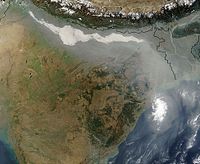
Photo from wikipedia
Port environments are highly dynamic and hotspots for marine bioinvasion. This study investigated the bacterial diversity at two geographically distant ports (Mangalore-marine port; and Haldia-riverine port) using next-generation sequencing during… Click to show full abstract
Port environments are highly dynamic and hotspots for marine bioinvasion. This study investigated the bacterial diversity at two geographically distant ports (Mangalore-marine port; and Haldia-riverine port) using next-generation sequencing during southwest monsoon and non-monsoon (Pre-monsoon) seasons. During southwest monsoon, at both marine and riverine ports, operational taxonomic units (OTUs) affiliated to bacteria reported to have hydrocarbon degrading ability were observed. Whereas during pre-monsoon, a significant increase in benthic bacterial OTUs was evident at the marine port, and the riverine port was characterized by oceanic species OTUs. Results suggest that the dynamics of prevalent environmental conditions, driven by seasons, led to emergence of ecologically relevant bacteria, many of which have been observed for the first time in Indian coastal waters. Their presence could be used as indicators of prevailing environmental conditions and nature of anthropogenic influence in port ecosystems. Unravelling functional roles of such ecologically relevant species is a way forward.
Journal Title: Marine pollution bulletin
Year Published: 2021
Link to full text (if available)
Share on Social Media: Sign Up to like & get
recommendations!